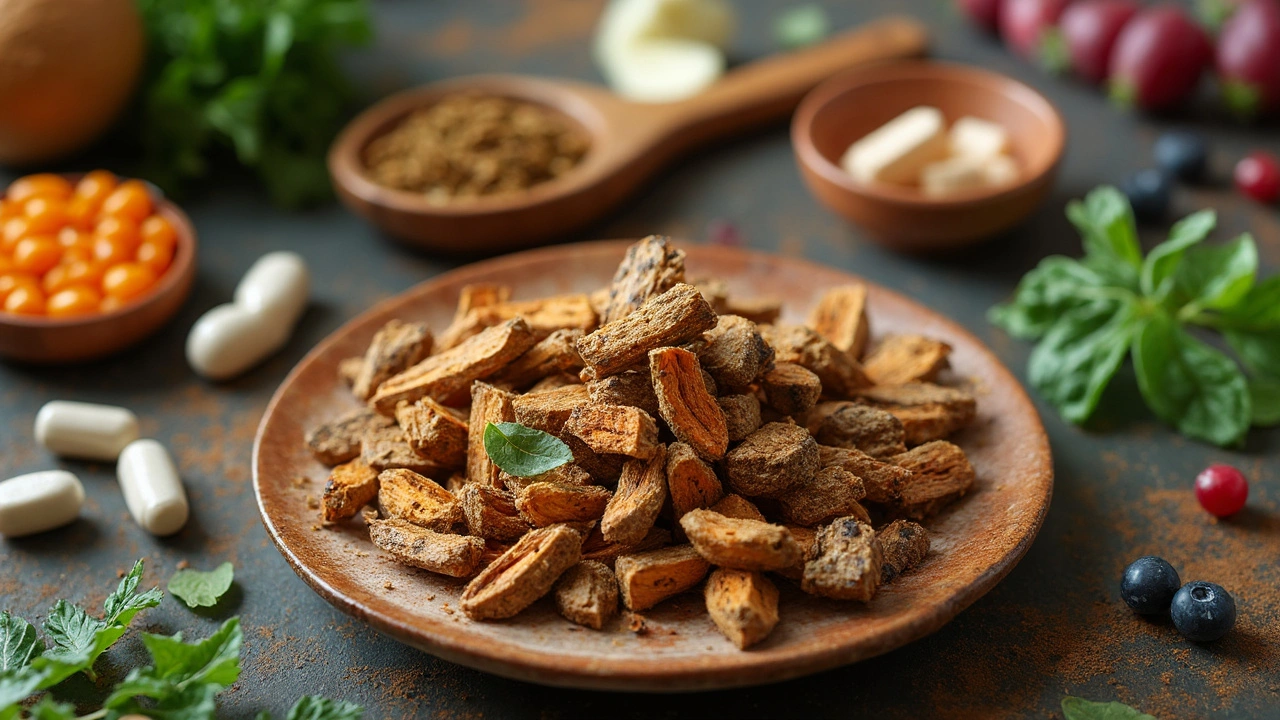Heard about Winter's Bark but not really sure what it is? You're not alone. This plant isn’t just some random leaf from the forest—it’s been used as a natural remedy for centuries in South America. Winter’s Bark is known for its spicy, aromatic bark, and folks have turned to it as a wellness boost especially during cold weather. Lately, it’s turning heads again as people want more natural ways to support their immune system and overall health.
What’s actually in Winter’s Bark that makes it special? For starters, it’s loaded with antioxidants and vitamin C. That’s a big deal if you’re trying to dodge coughs and sniffles. Plus, it has compounds that help fight inflammation, which is something your body can really use after a couple of long, chilly months. No need to hunt it down in some remote rainforest, either—nowadays you can find it in capsules, teas, and even liquid drops right at your local health store.
- What Is Winter's Bark?
- The Science Behind the Benefits
- Easy Ways to Add It to Your Routine
- What to Watch Out For
What Is Winter's Bark?
If you spot "Winter's Bark" on a supplement label and wonder what it actually is, here’s the real deal: it’s the bark from a tree called Drimys winteri. This evergreen grows in southern South America, especially around Chile and Argentina. Sailors first started using the bark way back in the 1500s after realizing it helped them fight off scurvy, thanks to its high vitamin C content. That’s actually how the tree got its name—Captain John Winter, one of the early users, was a navy guy who survived rough seas by relying on this stuff.
The bark itself is pretty tough, with a spicy flavor that’s been compared to pepper and a hint of cinnamon. Locals have used it for everything from flavoring foods to making teas and tinctures. What’s more interesting is what’s inside the bark. It’s packed with antioxidants, vitamin C, and anti-inflammatory compounds—making it stand out among natural supplements.
You’ll usually hear about Winter's Bark in the context of immune support or digestive health. Here’s a quick view of what it brings to the table:
- High in vitamin C—just a teaspoon of the ground bark delivers a noticeable boost
- Contains drimane sesquiterpenes, unique plant compounds thought to help with inflammation
- Has a history of use as an herbal remedy, especially during cold months
These days, it’s not just about old sailor legends. People add Winter’s Bark to their routine in capsules, teas, and tinctures, using it to support their immune system and help soothe digestion. So, it’s no surprise you’ll find Winter's Bark among the new wave of natural wellness trends.
The Science Behind the Benefits
The buzz around Winter's Bark isn't just about its spicy taste. There’s actual research backing up why this natural supplement is turning heads. Scientists have found that Winter’s Bark is loaded with antioxidants, especially vitamin C and some unique plant compounds that knock out free radicals. These are the same troublemakers tied to cell damage and early aging, so getting more antioxidants in your diet is never a bad thing.
One of the biggest reasons people grab Winter's Bark is for immune support. In one study, the bark was shown to help boost the body’s response against germs, which could mean fewer sick days during cold season. The vitamin C content isn’t just good for fighting off colds—your skin and joints get some love as well since it supports collagen production.
Feeling bloated after too many winter treats? There’s some talk, backed by small clinical trials, that Winter’s Bark can help calm the digestive system. It seems to help your gut move things along and may even ease general bloating. Plus, the anti-inflammatory action is real. Researchers point out that plants like this one help your body keep inflammation in check, and inflammation is tied to everything from sore muscles to bigger health problems like heart issues.
| Key Nutrients (per gram dry bark) | Amount |
|---|---|
| Vitamin C | ~36 mg |
| Polyphenols | ~14 mg |
| Flavonoids | ~7 mg |
But just to be clear, most studies involve concentrated extracts or higher doses than you'd get in an average cup of tea. So while the benefits are real, results will vary if you’re getting your herbal remedy from a supplement or just adding some bark to your mug. Always ask your doctor if you already take medications since even the most natural stuff can interact.

Easy Ways to Add It to Your Routine
If you’re ready to give Winter's Bark a shot, it’s actually pretty easy to work it into your daily habits. You don’t have to start foraging in weird places—most of the time, you’ll find it as a supplement at health food shops or online. Look for it in capsule, powder, or liquid extract form. The capsule and powder versions are super convenient if you want to avoid fuss.
Here are a few simple options you can try:
- Capsules: Probably the easiest method. Set a reminder and take it with breakfast so you don’t forget. Doses often range from 250 mg to 500 mg, but check what’s on the label and start on the low end if you’re new to it.
- Tea: The old-school way! If you’re into herbal teas, just steep a teaspoon of dried Winter's Bark in hot water for about 10 minutes. It has a bit of a spicy, cinnamon-like flavor that goes great with a squeeze of lemon or a dash of honey.
- Powder in Smoothies: If you’ve got the powder, throw half a teaspoon into your morning smoothie or yogurt. You barely notice the taste, but you get the benefits all the same.
- Liquid Extract: Got a busy schedule? Add a dropper of the liquid extract directly under your tongue or into a drink. Start with the recommended amount to see how you feel.
For people looking at the numbers, a 2022 consumer survey showed about 18% of folks who use natural supplements rotate in Winter's Bark during late fall and winter, especially in places with colder climates. They usually report using it three to five times per week for a few months at a time.
| Form | How To Use | Avg. Dose |
|---|---|---|
| Capsule | With food | 250-500 mg |
| Powder | In smoothies or yogurt | 0.5-1 tsp |
| Tea | Steeped 10 min | 1 tsp dried bark |
| Liquid Extract | Drop in drink or under tongue | Follow label |
One more tip—don't double up on the dose thinking you'll get faster results. Supplements like Winter's Bark don't work like that. Consistency matters more than taking a big amount at once. Try sticking with a daily routine for a month or so and pay attention to how you feel. If you’re on any meds or have health conditions, a quick check-in with your healthcare provider is a smart move before starting something new.
What to Watch Out For
Just because Winter's Bark sounds all-natural doesn’t mean you should dive in without a second thought. Some folks might have mild side effects, mostly if you take too much. Upset stomach is one of the most common issues—especially if you try to DIY your own strong tea or use a supplement dose way above what the label suggests.
Interactions with medications are another biggie. Since Winter's Bark can lower blood sugar, it’s smart to check with your doctor if you’re already on meds for diabetes or anything related to blood pressure. It's not very common, but there have been a few reports of allergic reactions, like skin rash or itchiness, in people who are sensitive to plants in the same family. If you’ve got a lot of allergies, definitely go slow your first time using it.
Most brands recommend sticking to a dose of about 250-500 mg per day if you’re taking it as a supplement. Don't assume that more is better—your body won't thank you for piling on extra. Pregnant and breastfeeding women should skip Winter's Bark just to be on the safe side since there's not enough solid info about how it affects babies.
- Always talk to your doctor before starting something new, especially if you’re taking medications.
- Start with the lowest dose and see how your body reacts.
- If you notice anything weird, like a rash or feeling dizzy, stop and get medical help.
According to a 2023 survey by the Natural Medicine Council, only 2% of users reported minor side effects, but it’s still smart to be cautious. Play it safe so you can actually get the benefits without any nasty surprises along the way.







Tim Giles
July 17, 2025 AT 23:28It's rather fascinating to see Winter's Bark gaining recognition in the wellness community, particularly given the growing interest in natural supplements as a means to enhance immune function. I find myself curious about the specific bioactive compounds that contribute to its reputed benefits. Are there comprehensive clinical studies that substantiate these claims, or is the current enthusiasm primarily driven by anecdotal evidence?
Moreover, it would be insightful to understand how this supplement compares to more established immune boosters such as echinacea or elderberry in terms of efficacy and safety profiles. Have there been any documented adverse effects or contraindications for certain populations? I imagine that integrating it thoughtfully into a wellness regimen requires an appreciation of such nuances.
Given that the article promises practical tips for usage, I wonder about the optimal dosages recommended for various age groups and whether there is a consensus in the nutritionist community on this matter. It is important to approach novel supplements with a balanced perspective, ensuring that expectations are aligned with scientific evidence rather than marketing hype.
Peter Jones
July 20, 2025 AT 18:26I appreciate the exploration of Winter's Bark here. Natural supplements that genuinely support our immune systems are always worth consideration, especially during colder months when the risk of infections rises. From my experience, it’s not just about the supplement itself but how it's integrated into a person’s broader wellness routine.
For instance, a good diet, regular exercise, and sufficient sleep all play pivotal roles. Supplementation should be viewed as an adjunct rather than the cornerstone of health. I wonder if the article touched upon synergistic combinations with other nutrients or whether Winter's Bark performs best solo.
Does anyone have experience combining it with vitamin D or probiotics? It would be great to hear how community members incorporate it practically and if they saw tangible benefits. Sometimes, natural remedies require patience and consistency to manifest effects.
Heather Jackson
July 22, 2025 AT 05:40omg y'all, ive been hearin bout winter's bark everywhere and this articl kinda nailed why it's so buzzed about. it's crazy how nature keeps givin us stuff that just WORKS without all the junk. 🌿 but like, pls be careful if ur tryin it for the first time, esp if ur sensitive to herbs or supplements cuz sometimes ppl forget that natural doesn't always mean safe for everyone.
also, idk if the article mentioned it but where do you even buy this stuff? some places might sell fake or low-quality powders which is a huge bummer. gotta trust the source or just check with a health pro before jumping in.
i'm definitely curious if anyone has started using it daily and can share real-life results?? like did u feel stronger immune-wise or less sick over the winter season? spill the tea!
Akshay Pure
July 25, 2025 AT 02:33Frankly, I am skeptical about this hype surrounding Winter's Bark. Many supplements flaunt the label 'all-natural' yet lack the rigorous empirical validation to support their claims. It's commonplace for the wellness industry to latch onto obscure botanicals without delivering meaningful physiological benefits.
That said, if one is serious about immune optimization, I would recommend a critical evaluation of its phytochemical constituents and subsequent clinical trial data. Until then, relying on it as a principal means of immune support is premature and somewhat naive.
Does anyone here possess firsthand experience under controlled conditions or any peer-reviewed evidence? I appreciate informed discourse, not mere marketing fulsome praise.
Matt Stone
July 26, 2025 AT 06:20Not buying the excitement unless there's hard data. A ton of supposed natural supplements get hyped every season. What exactly in Winter's Bark works better than anything else out there? Need specifics. How much should you take? Side effects? People need info not fluff.
Joy Luca
July 28, 2025 AT 13:53To add, it’s crucial we consider the biochemical interactions that Winter’s Bark ingredients might exhibit within complex human metabolic pathways. The immunomodulatory effects often attributed to botanicals stem from compounds that influence cytokine production and oxidative stress markers.
Standardization of extract composition and quality control are paramount to ensure reproducibility of outcomes. Without rigorous pharmacokinetic profiling, dosage forms remain speculative.
Anyone aware of any peer-reviewed randomized controlled trials validating Winter’s Bark’s purported immune benefits should share them here.
Jessica Martins
July 30, 2025 AT 21:26I appreciate the interest here, but I’d advise readers to exercise caution and consult healthcare providers before incorporating Winter’s Bark or any supplement, especially if they have pre-existing conditions or are on medications. Natural supplements can sometimes interact unpredictably.
Also, just because something is natural doesn’t guarantee safety or appropriateness. It’s great to be open to alternatives, but verification and professional guidance are key.
Doug Farley
August 1, 2025 AT 01:13Oh sure, another miracle plant to dump your cash on while the 'science' is still figuring it out. Gimme a break. Natural immunity boosters are a dime a dozen and they peddle this stuff like snake oil. If Winter’s Bark really worked, we’d have heard from mainstream medicine by now, not just wellness bloggers pushing it for clicks.
Anyone care to share more than the hype? Facts or it didn’t happen.
Jeremy Olson
August 3, 2025 AT 08:46This post presents an intriguing subject. Integrating natural supplements like Winter’s Bark into a wellness routine warrants attention. I agree that empirical evidence should guide usage, but anecdotal experiences can also be valuable. It might be beneficial for community members to share their personal regimens and outcomes.
Moreover, balancing scientific skepticism with openness to alternative therapies can foster a well-rounded approach to health.
Ada Lusardi
August 6, 2025 AT 20:06💫 This sounds soooo promising! Winter's Bark might be exactly what I need to get me through these harsh cold months without feeling drained all the time. The idea of something natural helping boost my immune system really appeals to me. ✨
I’m wondering how fast one might notice effects? Are there any tips on how to incorporate it into a daily routine without any hassle? Excited to hear from anyone who’s tried it.
Pam Mickelson
August 10, 2025 AT 07:26I've started using Winter's Bark this season after reading about its anti-inflammatory and antioxidant properties. Honestly, I've noticed an improvement in my energy levels and less frequent colds, though this is just my personal experience. It's not a substitute for a healthy lifestyle, but it feels like a helpful addition.
I take it in capsules every morning with my breakfast; no fuss at all! For anyone curious, I'd recommend starting with lower dosages to assess tolerance. Also, ensure your product comes from a reputable brand to avoid contaminants.